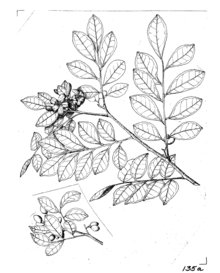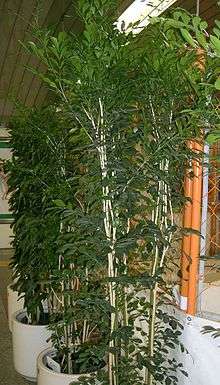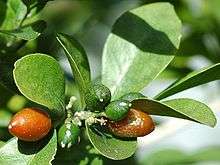Murraya paniculata
- "Orange jessamine" redirects here. This common name can also refer to Cestrum aurantiacum.
| Murraya paniculata | |
|---|---|
 | |
| Line drawing of Murraya paniculata, showing flowers and fruit | |
| Scientific classification | |
| Kingdom: | Plantae |
| (unranked): | Angiosperms |
| (unranked): | Eudicots |
| (unranked): | Rosids |
| Order: | Sapindales |
| Family: | Rutaceae |
| Genus: | Murraya |
| Species: | M. paniculata |
| Binomial name | |
| Murraya paniculata | |
| Synonyms[1] | |
| |
Murraya paniculata is a tropical, evergreen plant native to Southeast Asia and China.[2][3][4] bearing small, white, scented flowers, which is grown as an ornamental tree or hedge. Murraya is closely related to Citrus, and bears small orange to red fruit resembling kumquats, though some cultivars do not set fruit.
Common and local names
Some of the common names include
Orange jessamine, Jasmine orange,Chinese box, mock orange, mock lime, satinwood or Lakeview jasmine (mainly in Florida)
- Brazilian Portuguese: murta de cheiro, jasmim laranja
- Burmese: ယုဇန [jṵ zana̰] (from Pali yojana)
- Bengali: কামিনী
- Khmer: Sarika Keo
- Hindi: Kamini (कामिनी)[5]
- Indonesian: Kemuning
- Kannada: Kadu karibevu[5]
- Lao: ແກ້ວ [kɛ̂ːw]
- Malay: KemuningThe flower of Murraya paniculata, or Kamini, is found in Bana Bithan, Kolkata, West Bengal, India.
- Nederlands: Kemoening 'Nog pas gisteren' by Maria Dermoût p. 102
- Malayalam: Maramulla [5]
- Meitei: Kamini kusum [5]
- Marathi: Kunti (कुन्ती)[5]
Campeche, México: Limonaria[6]
- Mandarin Chinese: 月橘 (Pinyin: yué jú "moon tangerine")
- Hokkien and Cantonese: 七里香 "Seven li fragrance"
- Tagalog: Kamuning, Molawin
- Telugu: Nagagolungu[5]
- Tamil: Kattu Kariyilai or Vengarai (வெங்காரை)[5]
- Thai: แก้ว [kɛ̂ːw]
- Vietnamese: Nguyệt quất, Nguyệt quới[7]
- සිංහල: ඇට්ටේරියා , "Atteriya"
Description


Orange Jessamine is a small, tropical, evergreen tree or shrub growing up to 7 m tall. The plant flowers throughout the year. Its leaves are glabrous and glossy, occurring in 3-7 oddly pinnate leaflets which are elliptic to cuneate-obovate to rhombic. Flowers are terminal, corymbose, few-flowered, dense and fragrant. Petals are 12–18 mm long, recurved and white (or fading cream). The fruit of Murraya paniculata is fleshy, oblong-ovoid, coloured red to orange,[8] and grows up to 1 inch in length.[9]
Range
M. paniculata is a native of South and Southeast Asia, China and Australasia. It is naturalised in southern United States.
Uses
Traditionally, Murraya paniculata is used both in traditional medicine as an analgesic and for wood (for tool handles).
In the West, Murraya paniculata is cultured as an ornamental tree or hedge because of its hardiness, wide range of soil tolerance (M. paniculata may grow in alkaline, clayey, sandy, acidic and loamy soils), and is suitable for larger hedges. The plant flowers throughout the year and produces small, fragrant flower clusters which attract bees, while the fruits attract small frugivorous birds.[9]
Honey bee farms have been known to plant Orange Jessamine near bee hives. Serving not only as food for the bees but as protection from harsh winds. Honey collected from bee hive colonies that collect pollen from orange jessamines, have a tangy sweet orange undertone.
Propagation
The Orange Jessamine is sexually propagated by its seeds. The fruits are eaten by birds, who then pass the seeds out in their stool. It may also be artificially propagated by softwood cuttings.[9]
Diseases
M. paniculata is vulnerable to soil nematodes, scales, sooty mold and whiteflies.[9]
M. paniculata is the preferred host to the insect pest Diaphorina citri, the citrus psyllid. This psyllid is the vector for the citrus greening disease.[10]
Potential medicinal uses
The crude ethanolic extract of leaves of Murraya paniculata has antidiarrhoeal, antinociceptive,[11] anti-inflammatory [12] and analgesic activity[13] Yuehchukene, a dimeric indole alkaloid, can be extracted from the root.
Notes and references
| Wikispecies has information related to Murraya paniculata |
| Wikimedia Commons has media related to Murraya paniculata. |
Footnotes
- ↑ "The Plant List: A Working List of All Plant Species". Retrieved 8 April 2015.
- ↑ "World Economic Plants: A Standard Reference, Second Edition - John H. Wiersema, Blanca León - Google Books". Books.google.com.au. 2013-03-20. Retrieved 2016-04-03.
- ↑ "Weeds Australia - Weed Identification - Murraya". Weeds.org.au. Retrieved 2016-04-03.
- ↑ "Archived copy". Archived from the original on June 2, 2015. Retrieved June 4, 2015.
- 1 2 3 4 5 6 7 "Murraya paniculata - Kamini". Flowersofindia.net. Retrieved 2016-04-03.
- ↑ http://www.medicinatradicionalmexicana.unam.mx/monografia.php?l=3&t=limonaria&id=7414
- ↑ "Nguyệt quới". Hue University. Retrieved 14 November 2015.
- ↑ Welsh, 1998; pp 256
- 1 2 3 4 Gilman, Edward F. Factsheet FPS-416, October 1999; University of Florida Cooperative Extension Service, Institute of Food and Agricultural Sciences; from "Archived copy" (PDF). Archived from the original (PDF) on 2007-09-28. Retrieved 2007-06-28. retrieved on 28 June 2007
- ↑ retrieved on 28 June 2007
- ↑ "Antinociceptive and bioactivity of leaves of Murraya paniculata (L.) Jack, Rutaceae. Sharker S.Md., Shahid I.J., Hasanuzzaman Md. Brazilian Journal of Pharmacognosy. 19 (3) (pp 746-748), 2009.
- ↑ Rahman M.A., Hasanuzzaman M., Uddin N., Shahid I.Z.,Antidiarrhoeal and anti-inflammatory activities of Murraya paniculata (L.) Jack." Pharmacologyonline. 3 (pp 768-776), 2010.
- ↑ "Murraya paniculata (L.) Jack: A Potential Plant for Treatment of Toothache". symbiosisonlinepublishing.com. Retrieved 2018-03-20.
References
- Welsh, S. L. 1998. Flora Societensis: A summary revision of the flowering plants of the Society Islands E.P.S. Inc., Orem, Utah.